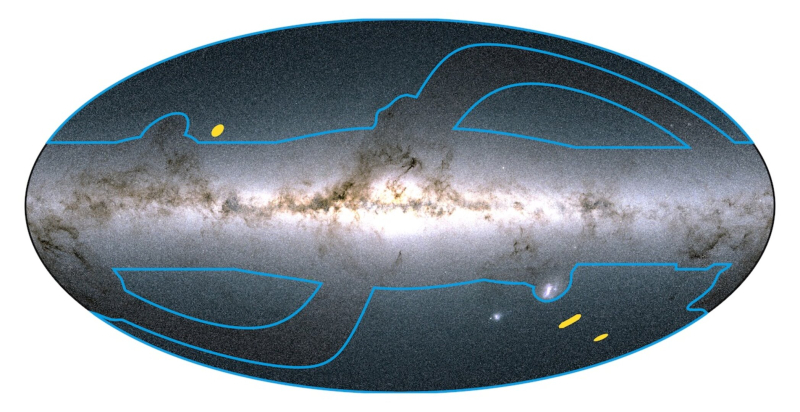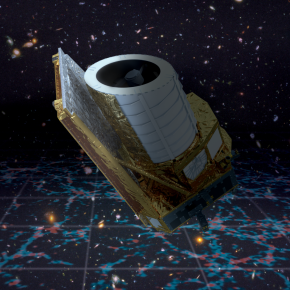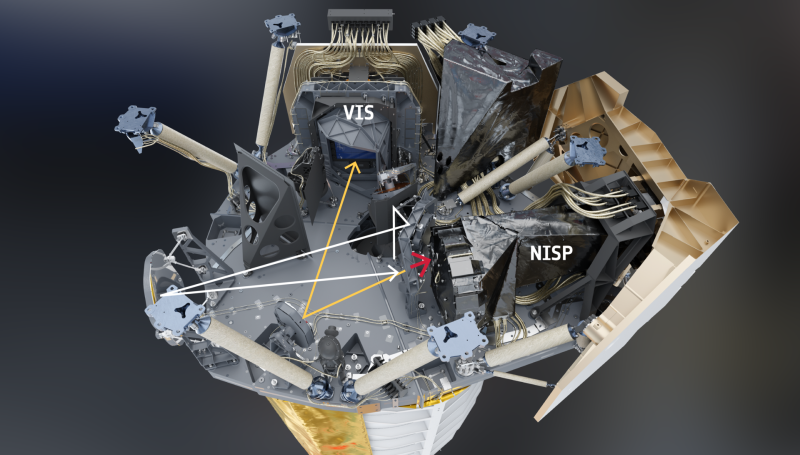Euclid Mission: Unlocking the mysteries of the Universe
The Euclid satellite, to be launched in July 2023, will attempt to unlock the secrets of the Universe by exploring the composition and evolution of the dark Universe. For 6 years, the European Space Agency’s (ESA) Euclid mission with its space telescope will produce a large-scale map of the Universe across space and time by observing billions of galaxies up to 10 billion light-years away, over more than a third of the sky. Euclid will shed light on the phenomenon of the expansion of the Universe and its acceleration by trying to decipher the role of gravity and the nature, still unknown to this day, of dark matter and energy which represent more than 95% of the mass and energy of our Universe.
Euclid is the result of an international collaboration, involving scientists from CNRS-INSU. The Euclid Consortium – composed of more than 1500 scientists from 300 laboratories and institutes in 17 different countries (1) – has provided the scientific instruments and will participate in the production and analysis of scientific data.
Before the satellite’s departure for the United States in April, we look back at the challenges of this mission with Yannick Mellier, an astronomer from Sorbonne University at the IAP and PI of the mission; Sophie Maurogordato, CNRS research director at the Lagrange laboratory; Nabila Aghanim, CNRS research director at the IAS; and Vincent Le Brun, teacher-researcher at Aix-Marseille University at the LAM.
The mysteries of dark matter and dark energy
Ordinary matter consists of the elementary particles described in the standard model of particle physics. This includes quarks and electrons, which together form atoms. Ordinary matter attracts other ordinary matter, depending on its mass, via gravity. This force explains why the Earth revolves around the Sun and why the Sun revolves around the center of the Milky Way galaxy. But ordinary matter is only a small fraction of what the Universe contains. Indeed, stars in galaxies move faster around their center than ordinary matter could explain. Ordinary matter would not be able to create enough gravity to hold these galaxies together. The source of this missing gravity is what is called dark matter and its presence tends to hold back the expansion of the Universe.
The primary objective of the mission is to determine why the expansion of the Universe is accelerating. The source of this acceleration, “dark energy”, is completely unknown at this time. It may be a new fundamental interaction of nature, the cosmological constant or the fact that at cosmological scales the effects of gravitation deviate significantly from the predictions of Einstein’s theory of general relativity. The Euclid space mission will provide a decisive answer to this question by mapping the distribution of dark matter and galaxies and their respective evolution over the last 10 billion years. Euclid will establish this “cosmic tomography” by observing 15000 deg-squares of the sky (one third of the entire sky), with a 1.2 meter diameter, wide field telescope.

Euclid mission: A revolution for astronomy
Euclid will perform a high-precision mapping of dark matter thanks to the gravitational shear (2) caused by it. Ordinary matter and dark matter are not uniformly distributed in space, but arranged in filamentary structures often called “cosmic web”. The change in dark matter over time and the clustering of its global spatial distribution reveal the role and properties of dark energy. Combining statistical power with a large redshift coverage (3), Euclid’s galaxy cluster catalog will be revolutionary, especially for the characterization of high redshift clusters.
Euclid is an extraordinary instrument for a multitude of projects beyond cosmology and the dark universe. During its mission, Euclid will observe every 3 to 5 days the equivalent of the entire sky covered by the Hubble telescope in 30 years. From this point of view, it is a new era for astronomy. The statistical analysis of hundreds of millions of galaxies over 10 billion years or, at the other extreme, the detection of rare objects, such as ultra-cold stars, small solar system objects, galaxies with very low surface brightness or populations of quasars (4) with very high spectral shift will be fed by Euclid data, and this for several decades.
The instruments involved in an unprecedented mapping
The space telescope, built by Airbus Defense and Space, will feed photons to two instruments, a visible imager (VIS) and an infrared spectrometer-photometer (NISP), which will observe the same fields in parallel during 6 years. It will be positioned at the Lagrange point L2 located at 1.5 million kilometers from the Earth. The Euclid satellite that hosts the telescope and its instruments is built by Thales Alenia Space Italy. It will be launched in July 2023 with a SpaceX Falcon 9 rocket from Cape Canaveral, Florida. The mission will collect a considerable amount of data (several Petabytes in 6 years, carrying more than 10 billion sources and 35 million spectra of galaxies). The magnitude of the processing of these pixels makes Euclid a mission out of the ordinary, the heaviest and most complex ever implemented by ESA and the consortium in terms of data management and processing.

With its VIS instrument, Euclid will measure the tiny gravitational deformations of the images of distant galaxies generated by all the dark matter distributed along the line of sight. The statistical analysis of these tiny deformations as a function of the angular scale on the sky and of the distance to the observer (thus of time (5)) allows to reconstruct the distribution of dark matter and its evolution with an extreme precision allowing to “see” the perturbing effects of dark energy on the growth of the large structures of the Universe as a function of time. The VIS instrument is sensitive to wavelengths ranging from green (550 nm) to near infrared (900 nm). It uses a mosaic of 36 CCDs (6) which gives the detector a total of about 600 megapixels, equivalent to nearly seventy screens of 4K resolution.
NISP is a combined camera/spectrograph that measures near infrared light (900-2000 nm) using a grid of 16 detectors (7) . The scientific objectives of Euclid require to observe very distant galaxies to determine the amount of light they emit per wavelength. NISP will measure the redshift of galaxies, which cosmologists can use to estimate the distance between each galaxy. The particularity of NISP is that it will be able to observe the spectra of all the galaxies present in its field of view, contrary to the traditional spectrographs which require a preliminary selection of the targets.
Thanks to the coupling of VIS and NISP, and from the position of the galaxies and their distance, it will be possible to establish the largest and most precise 3D map of the Universe ever made. With this map, scientists will be able to study how the distribution of these filamentary structures changes over time to learn more about dark matter (which affects gravity) and dark energy (which affects the expansion of the Universe).

A large-scale scientific analysis
The core of the simultaneous scientific analysis of VIS and NISP data will focus on the detection, characterization and evolution of the large structures of the Universe over the last 10 billion years. It will allow to explore with extreme precision all cosmic scales from galaxies to the largest filaments of dark matter and visible matter. These instruments will also allow an unprecedented mapping of the distribution of galaxy clusters. As the most massive gravitationally bound structures in the Universe, these clusters are cosmological indicators to characterize matter and dark energy on which their abundance depends according to their mass and redshift. A model of the Universe with a high density of matter will for example produce more clusters than if the density is low. Similarly, dark energy affects both the comoving volume component (8) and the growth rate of structures, and thus the number of clusters formed over time. We therefore expect a modulation of the number of clusters as a function of the redshift characteristic of the dark energy model considered.
Euclid will work continuously: the telescope will observe 20/24h and the remaining 4 h will be used to transfer the data to Earth. Upon reception on Earth, the data will be checked and then processed by the consortium’s processing chain to progressively map the distribution of dark matter and galaxies by about 1 billion years. These data will be exploited immediately by the scientists of the consortium and then made public about 6 months later. The processing and scientific analysis of Euclid data is a titanic task that involves several hundred researchers and engineers.
Notes
- Austria, Belgium, Denmark, Finland, France, Germany, Italy, Netherlands, Norway, Portugal, Romania, Spain, Switzerland, United Kingdom, United States, Canada, Japan.
- Matter can locally distort space-time, changing the path of light and thus distorting the image of galaxies and clusters in the background.
- Redshift of galaxies, a sign that they are moving away from the instrument that observes them, according to the Doppler effect.
- A quasar is a super massive black hole in the center of an extremely luminous region such as the active nucleus of a galaxy.
- The speed of light being finite, when we observe a distant object we see it as it was at the time of light emission. For galaxies, we do not speak of minutes but of millions and billions of light years. So scientists go back in time and into the past.
- Charge Coupled Devices, a type of camera sensor.
- NASA provided the near-infrared detectors for the NISP instrument.
- Volume calculated by following the expansion of the universe.
CNRS-INSU laboratories involved
The consortium, which includes scientists from CNRS-INSU, is responsible for the construction of the scientific instruments, the realization of the data processing chain, the production of calibrated images and catalogs that will be delivered to the world scientific community, as well as the scientific exploitation. Laboratories of IN2P3 are also involved in the mission.
- The Institut d’Astrophysique de Paris (IAP) is responsible for the scientific aspects of the mission, for the management of the Euclid Consortium, for the production of data obtained with the VISible imager and participates in the system team of the ground segment and data management. Tutelles : Sorbonne University / CNRS
- The Institut d’Astrophysique Spatiale (IAS) / OSUPS is responsible for the design, realization and delivery of the VIS calibration system (Calibration Unit). It is responsible (with INAF Trieste and LMU Munich) for the MER Organisational Unit of the Ground Segment, in charge of the fusion of VIS and NISP data and the production of the galaxy catalog. Tutelles : Université Paris-Saclay / CNRS
- The Laboratoire d’Astrophysique de Marseille (LAM) / PYTHEAS is responsible for the NISP instrument and is the prime contractor. It provided the mechanical structure in silicon carbide as well as the grisms. The tests in space environment, of qualification and verification of the performances of the instrument were carried out in the large cryogenic tank of the LAM developed with the support of the CNES. Tutelles : Aix-Marseille University / CNRS / Cnes
- The Lagrange Laboratory / OCA ensures since 2012 the responsibility of the Workpackage Clusters of galaxies Implementation of the Organization Unit LE3 of the Scientific Ground Segment jointly with the INAF, Trieste. This workpackage coordinates the implementation of algorithms to detect, characterize and analyze the clustering properties of galaxy clusters. It coordinates the pipeline dedicated to the Sol Segment clusters and is responsible for the delivery of the Euclid galaxy cluster catalog as well as the scientific working group dedicated to the solar system, and is responsible for the True Universe stellar simulations. Tutelles : Université Côte d’Azur / CNRS
- Astrophysics Instrumentation and Modeling (AIM) is co-responsible for the design, construction and integration of the instrument’s focal plane as well as the electronic control box of the cold elements. Tutelles : Université Paris Diderot / CNRS / CEA
- Institute of Research in Astrophysics and Planetology (IRAP) / OMP. Tutelles : University Toulouse 3 – Paul Sabatier / CNRS / CNES
Further Resources
- The Euclid mission on the ESA website.
- The Youtube channel of the mission to know more about the scientific exploitation and the instruments.
IRAP Contact
- Alain Blanchard, alain.blanchard@irap.omp.eu






